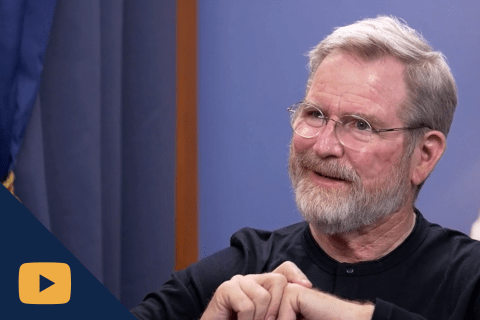
This second article in a series of three is drawn from Dr. Jonathan Reyes’ “Making the Gospel ‘Real’ in a Gnostic World,” delivered as the sixth annual Saint Hildegard Lecture hosted by the University of Mary’s Catholic Studies program. Click here to start from the beginning.
In a moment, I will offer brief descriptions of the two ideological religions of our day. Before I do that, however, I want to share two insights that will set the stage. The first is from Christopher Dawson, the second is from St. John Henry Newman.
Dawson is perhaps best known for his insistence – evidenced by his historical studies – that at the root of every culture is a religion, and that for culture to exist the people need to agree on a fundamental picture of the world. This picture of the world always tells a story and answers the most important questions in life: What is good? What is evil? What is life for? What is death? Where am I going? The story of the last few hundred years, Dawson believed, was the story of the West losing its religion – Europe denying its Christian roots. The choice, as he saw it, was for the West to either recover its Christian roots or to await the new religious vision that would become the heart of the culture. What was not an option was a culture without an organizing vision of reality. It should not surprise us that as the process of de-Christianization has progressed, alternative religious visions have competed to provide the organizing principle of the culture – from the positivistic dreams of the nineteenth century, to the horrors of the totalitarian experiments of the twentieth century, to the overconfidence and victory of capitalism and liberalism at “the end of history.” What has been unique in all human history about each of these alternative religious visions and continues to characterize the main ideological visions we will discuss in a moment is that they are explicitly non-transcendent. As a first principle, they deny the existence of non-material reality.
The importance of first principles leads to my second point, which I’m taking from Newman. In an 1865 letter, Newman wrote, “An evil time is before us. Principles are being adopted as starting points, which contradict what we know to be axioms.” He further observed that the proponents of radically atheistic visions of the world “ignore religious first principles but assume first principles of their own without any compunction. The result of their dogmatism was that there is a general antecedent leaning to the side of unbelief as more reasonable and probable.” So to understand the religions of the day and to engage them in a meaningful way, we must get to the level of first principles. This explains the problem, I think, with a lot of our public discussions: we don’t get to first principles, but instead talk about conclusions drawn from first principles. Washington, DC, is caught up in an ongoing conversation about policy issues that are rooted in first principles, but ultimately we just end up talking past each other all the time. So we have to dig down to the level of first principles – of starting points – or there’s really no way forward. When we get to the level of first principles, the other side begins to make more sense, even if we don’t agree. At least we’ll then know where the problem is. Until we get to that level, we’re stuck at the level of “can you believe those crazy people believe that?”
So what story does Christianity tell? What are our starting points?
The Christian vision says that humans are creatures made by God in his image and likeness, with a destiny and a nature. We were made out of love and therefore for communion with God and one another. The law of good and evil is inscribed in our nature and has been made explicit through revelation. Revelation is not only possible but real, and it tells us things about reality that we could not discover but are nevertheless reasonable. Reason and faith work together.
The Christian vision says that there was a Fall – a prideful rebellion of angels followed by that of humanity. From that Fall, death and sin entered the world and the human race has since lived under the curse of its own rebellion. This Fall explains the suffering, injustice, and alienation we all see and experience. This Fall severely wounded human beings, but did not eradicate within them the desire for eternal life. Human beings are unable to fix the situation by ourselves, and God had to intervene to redeem the human race. Human beings, while still wounded by the Fall, which has also wounded our social relations, have by grace the ability to accept this act of redemption and once again fulfill our destiny to live forever in union with our loving Creator.
That is the Christian account. What then are the other explanations for human life out there and what do they promise?
There’s no perfect way to label these two accounts. I’m going to use somewhat awkward labels because I’m trying to avoid language that would deliberately condemn or praise them. The labels I’ve decided to use are the techno-naturalist vision and the equity-justice vision.
Both of these visions have something important in common: they’re both salvation stories. They both acknowledge limits and problems and offer a way to overcome them in order to usher in a new pseudo or fully utopian human reality. It’s important to see this, because if we miss the aspirational promises of these visions, we miss an important part of their imaginative power. Why do these visions grab us? Because of what they promise. These are yearnings we all have – it makes perfect sense. An effective evangelistic strategy that encounters another religion must at some level attempt to address the concerns and aspirations of that religion and show how they are better addressed by Christ. We need to tell a better story.
So let’s begin with the techno-naturalist vision. This vision is rooted in the physical sciences. It takes as a first principle that only knowledge gained through the empirical sciences is valid. It proceeds to tell the story of the origin of the human race through the lens of evolutionary biology, primarily with physics. For a compelling and influential version of the story, I recommend Yuval Harare’s Sapiens: A Brief History of Humankind. It's one of the best versions of the story available.
The story in brief is that human beings are the product of the random interaction of forces and particles over millions of years. The key moment in this story is the evolution of consciousness. This is where the story gets a bit fuzzy. It’s difficult, if not impossible, for purely material causes to explain the mind. Nonetheless, it follows from this human origin story that human beings have no inherent nature, that there’s no universal moral code by which humans are to live, and that there is no transcendent goal for human beings. The goal of human beings is simply to stay alive and fulfill their desires without getting in the way of each other. So a good society, on this view, is one that allows human beings the maximum amount of freedom (with a couple limitations) to do whatever they want.
But there’s even more to this story. If taken to its logical conclusion, this materialist account leaves open the possibility of human perfectibility. As one critical philosopher put it, “The human mind is understood as an epiphenomenon of the brain’s neurological processes; human choices are predicted with statistical precision and unmasked as ultimately driven by the interests of the ‘selfish gene.’ In short, humans are nothing more than highly advanced primates that will eventually be completely transparent to the analytical gaze of the natural sciences.” In a purely materialistic worldview, human beings are ultimately perfectly understandable and therefore hackable, to use a modern phrase. We can use this knowledge – at least the few who possess it – to change human behavior and make the world a better place, if not perfect.
This knowledge, coupled with our technological advancement and applied to human biology, can also serve to liberate us from the very confines of our humanity. We can overcome death, finding ways to keep minds alive when our bodies fail. We can enhance our abilities with technology to become more than human. Reinhard Huetter described this transhumanism as, “the angelism of the putatively disembodied sovereign subject that subjects to its will an absolutely malleable and fluid external world.” Granted, not every version of this myth is compelling – some of it sounds like 1970s science fiction reworked. But frankly the whole arc of the story – that there’s a way out of the human dilemma buoyed on technological advancement – has great potency. It was, after all, the desire to take God’s place that led the devil to rebellion, and it was the desire to be like God that accounted for the Fall of our first parents. The dream of being gods is a very old one, and given our inherent temptation to pride and the awe-inspiring technological advances of the day, it can be a very attractive dream. And frankly, we understand the good and healthy desire for eternal life – to be more than we currently are.
So if the techno-naturalist vision is expressed in scientific, reasonable language, as Yuval Harare has done, it can seem quite plausible. Over 12 million copies of his books have sold, and we know that due to electronic media it is likely that his ideas themselves have spread to tens of millions more. This is, in part, evidence of his talent to communicate ideas – he’s a wonderful writer. But frankly, I think it points to something deeper: people already believed these things, or wanted to believe them. Truly original books are never popular at first: they take a while to be discovered. It’s those accounts of reality that organize and powerfully express those assumptions and dogmas already widespread in society that gain instant acclaim. In this case, the assumptions and dogmas are those that attach mythic hope to things like genetic engineering, the metaverse, the virtual global community of peace, chips in our brains, the colonization of the planets, and eternal life on earth. As C. S. Lewis once observed, “every age gets, within certain limits, the science it desires.”
The equity-justice vision doesn’t start with science, but with ethics. Here the concern is justice – or better, injustice. This vision starts with the observation that some groups of people have oppressed other groups throughout history, as evidenced by historical events and present disparities of outcomes. It takes as a first principle that people are fundamentally defined by their group identities. Thus, the story of the human race is one in which one immutable group of people is always seeking to dominate another such group. In order to sustain this oppression, the dominant group develops systems, structures, and language patterns that ensure their continued rule. This view is also inherently Manichaean: there are good people – the oppressed – and there are bad people – the oppressors. Because identity is fixed, there is no way to go from being a bad person to a good person, or vice versa. You can become enlightened, you can come to see your privilege and repent of it – but if you are among the privileged, you can’t change your identity. If you are among the oppressed, you too can become enlightened and give your life to social change, confident that you’re always by definition on the side of the right.
This vision, too, holds out a great promise. Through revolution, a new world can be born marked by equity and justice. And we mean “revolution” quite literally – the entire system needs to be done away with. I don’t think I need to insist with you how widespread these ideas are: they’re in the very air we breathe! But I think we need to note that they start with real problems: injustice and alienation. They start with real desires: we want justice and community. There are reasons for the outrage and longing – these are genuine results of a fallen world. We’ve seen examples of injustice and each of us knows personal alienation. As Cardinal Ratzinger wrote, “Poverty, oppression, unjust domination of every kind, the suffering of the righteous and of the innocent are the signs of the times—in every age. And each single person is suffering; no one can say about the world, or about his own life: ‘Stay yet awhile, you are so lovely.’”
The unhappiness and the ethical outrage that drive this view of the world are real, and I think it’s important that we engage at this level. Any effort to share the Gospel with people who think this way must take the suffering of personal alienation and injustice seriously. This is what I meant earlier by saying that we must see the concerns and aspirations of these religions and offer a better account of how to deal with them. As Newman said, “This is the secret of the influence, by which the Church draws to herself converts from such various and conflicting religions. They come, not so much to lose what they have, as to gain what they have not; and in order that, by means of what they have, more may be given to them.” It’s not a matter of denying the longings for justice and full communion that drive this worldview – it’s a matter of offering the only way that can truly achieve it.
In addition to this, we should also observe the internal logic of this vision. If you take as first principles that group identity is fixed and that unequal relations among group identities are the product of one group unjustly asserting power over another, then the arguments and eventual policies that find their way into human resources departments, for example, actually make sense. The conclusions follow from the premises. Again, we must go back to first principles, because if we don’t start there we’re not going to get to the root of the problem.
One final comment on these two worldviews: there’s something very new about them. In fact, they wouldn’t exist if we didn’t have the particular technology and social developments we have. But there’s also something about them that’s not so new. As others have noted, the beliefs that we can overcome the limits of human nature and escape bodily existence through a secret knowledge, and that we can use this knowledge to create a perfect world, are actually very old ideas. They’re the core convictions of that perennial heresy called Gnosticism. Now, for those of you who’ve read history, sometimes the word Gnosticism can conjure up rather quirky ideas about ranks of spiritual beings, demiurges some kind of escapism, and strange ascetic practices. But at its most fundamental level, Gnosticism is a heresy that denies human bodily limitations, that believes that a special knowledge is capable of unlocking secret truths of all reality, and through the application of these secret truths, human perfection can be achieved.
So if these are the two Gnostic ideologies of our modern age, how are we to respond to them? What are we to do about our present situation?

Next: Strategic Recommendations for Evangelization in a Gnostic World
Christians living in the midst of the Gnostic visions of the modern world will benefit from five key recommendations based on St. John Henry Newman's insights into belief and imagination.

Previous: Making the Gospel ‘Real’ in a Gnostic World
There is a particular urgency for evangelization today. Catholic universities are uniquely positioned to play a powerful role in evangelization.


